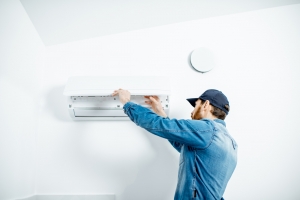Living in Arizona's breathtaking desert landscape offers countless benefits—stunning sunsets, year-round outdoor activities, and a vibrant community that celebrates the beauty of Southwest living. However, beneath the surface of this desert paradise lies a hidden challenge that many residents don't fully understand: the unique air quality issues that can significantly impact your daily wellness and long-term health.
From the infamous haboobs that roll across the Phoenix Valley to the microscopic dust particles that infiltrate our homes daily, Arizona's environment presents specific respiratory challenges that require thoughtful management. Understanding these challenges and taking proactive steps to address them isn't just about comfort—it's about creating a foundation for optimal wellness that allows you to truly thrive in the desert.
The Hidden Health Impact of Desert Air
Arizona's air quality challenges extend far beyond what meets the eye. While the state's low humidity and abundant sunshine create an appealing climate, they also contribute to conditions that can affect your respiratory system, energy levels, and overall sense of well-being in ways you might not immediately connect to your environment.
The desert's fine particulate matter, known as PM2.5, consists of particles so small they can penetrate deep into your lungs and even enter your bloodstream. Unlike larger dust particles that your body can filter naturally, these microscopic invaders can trigger inflammatory responses, exacerbate allergies, and contribute to fatigue that many residents attribute to other causes.
What makes Arizona particularly challenging is the combination of natural desert dust with urban pollution. Cities like Phoenix and Tucson sit in valley basins that can trap pollutants, creating a bowl effect where contaminants accumulate rather than disperse. During certain weather patterns, this creates a perfect storm of air quality issues that can leave even healthy individuals feeling sluggish, congested, or experiencing unexplained respiratory irritation.
The psychological impact shouldn't be overlooked either. Poor air quality can affect sleep quality, cognitive function, and mood regulation. When you're constantly breathing compromised air, your body expends extra energy filtering toxins, leaving less energy for the activities and experiences that bring joy to your life.
Understanding Arizona's Unique Air Quality Challenges
Living in the Sonoran Desert means adapting to environmental conditions unlike anywhere else in the world. Arizona faces a perfect storm of natural and human-made air quality challenges that require specific strategies for management.
Dust storms, or haboobs, represent the most dramatic example of Arizona's air quality challenges. These massive walls of dust can reduce visibility to zero and fill the air with particles that linger for days after the storm passes. While haboobs capture headlines, the daily reality of desert living involves constant exposure to lower levels of airborne particles that accumulate over time.
The state's geography creates natural air quality challenges through what meteorologists call "inversions." During cooler months, warm air masses can trap cooler air close to the ground, creating a lid effect that prevents pollutants from dispersing. Combined with the Phoenix Valley's basin geography, this creates conditions where air quality can deteriorate rapidly during certain weather patterns.
Seasonal variations add another layer of complexity. Spring brings increased wind that stirs up dust and pollen, while summer's extreme heat creates ground-level ozone formation. Winter inversions can trap pollutants close to the surface, and the increased use of heating systems during cooler months adds additional particles to the air.
The rapid urban growth across Arizona has intensified these challenges. Construction activities generate additional dust, increased vehicle traffic contributes to emissions, and the expansion of paved surfaces creates heat islands that affect air circulation patterns. Understanding these interconnected factors helps explain why traditional air quality management approaches may fall short in Arizona's unique environment.
The Wellness Connection: How Air Quality Affects Your Daily Life
The relationship between air quality and wellness extends far beyond obvious respiratory symptoms. Poor air quality creates a cascade of effects that can impact virtually every aspect of your daily experience, often in ways that aren't immediately obvious.
Sleep quality represents one of the most significant yet underrecognized impacts of poor indoor air quality. When your bedroom air contains elevated levels of dust, allergens, or pollutants, your body works harder during sleep to filter these contaminants. This extra effort can prevent you from reaching deeper, more restorative sleep stages, leaving you feeling tired despite spending adequate time in bed.
Cognitive performance also suffers when air quality is compromised. Research consistently shows that elevated CO2 levels and particulate matter can reduce decision-making ability, slow reaction times, and impair memory formation. For remote workers or students spending significant time indoors, this connection between air quality and mental performance becomes particularly important.
Physical energy levels fluctuate dramatically based on air quality conditions. When your respiratory system works overtime to filter contaminated air, less oxygen reaches your muscles and organs efficiently. This can manifest as unexplained fatigue, reduced exercise tolerance, or a general feeling of sluggishness that many people mistakenly attribute to aging or stress.
Emotional well-being intertwines closely with air quality through multiple pathways. Poor air quality can trigger stress responses in the body, disrupt hormone balance, and affect neurotransmitter production. Many Arizona residents notice mood improvements on days when air quality is better, though they may not consciously connect these fluctuations to their environment.
Creating Your Personal Air Quality Action Plan
Developing an effective strategy for managing Arizona's air quality challenges requires both immediate actions and long-term planning. The goal isn't to create a sterile environment, but rather to optimize your indoor air quality while minimizing exposure to problematic outdoor conditions.
Start by understanding your local air quality patterns. Phoenix, Tucson, and other Arizona cities provide real-time air quality monitoring that can help you plan outdoor activities and adjust indoor strategies accordingly. Learning to interpret Air Quality Index (AQI) readings empowers you to make informed decisions about exercise timing, window opening, and outdoor exposure.
Monitor your body's responses to different conditions. Keep a simple wellness journal noting energy levels, sleep quality, and respiratory comfort alongside daily air quality readings. This personal data helps identify your individual sensitivity patterns and guides decision-making about when to take additional precautions.
Timing becomes crucial for outdoor activities in Arizona. Early morning hours typically offer the best air quality, as overnight cooling allows particles to settle and winds haven't yet stirred up dust. Plan exercise, outdoor work, and recreational activities during these optimal windows when possible.
Indoor air management requires consistent attention to filtration, humidity control, and source reduction. Regular attention to these factors creates a refuge space where your body can recover from daily exposure to challenging outdoor conditions.
Optimizing Your Home's Air Quality System
Your home represents your primary sanctuary from Arizona's air quality challenges, making indoor air management a critical component of desert wellness. Creating an effective indoor air quality strategy involves understanding both mechanical systems and lifestyle practices that work together to maintain healthier air.
Advanced filtration forms the foundation of effective indoor air quality management. Standard air filters capture larger particles but allow smaller, more problematic particles to circulate freely. High-efficiency particulate air (HEPA) filtration removes 99.97% of particles larger than 0.3 microns, including the fine dust that characterizes Arizona's air quality challenges.
However, filtration alone isn't sufficient in Arizona's extreme environment. The state's low humidity creates additional challenges, as dry air can increase dust circulation and respiratory irritation. Proper humidity control maintains indoor humidity levels between 30-50%, reducing dust circulation while preventing the mold growth that can occur in more humid climates.
Air circulation patterns dramatically affect how well your systems can maintain healthy air quality. Properly designed ventilation systems create gentle air movement that prevents stagnation while avoiding drafts that can stir up settled particles. This becomes particularly important in larger homes or spaces with complex layouts.
Regular maintenance takes on heightened importance in Arizona's dusty environment. Air filters require more frequent replacement than in other climates, and system components need regular cleaning to maintain optimal performance. Professional HVAC maintenance ensures that your systems operate at peak efficiency when you need them most.
Source control represents the often-overlooked foundation of indoor air quality. This includes managing entry points where outdoor air enters, controlling indoor pollution sources, and maintaining cleanliness standards that prevent particle accumulation.
Lifestyle Strategies for Desert Air Quality Management
Beyond mechanical systems, daily lifestyle choices significantly impact your exposure to air quality challenges and your body's ability to cope with environmental stressors. Developing sustainable habits that support respiratory health creates a comprehensive approach to desert wellness.
Timing your exposure to outdoor air makes a substantial difference in your daily pollutant load. Monitor local air quality forecasts and plan outdoor activities during optimal conditions. When air quality is poor, consider indoor alternatives for exercise and recreation rather than compromising your respiratory health.
Hydration takes on special importance in Arizona's dry climate and challenging air quality conditions. Proper hydration helps your respiratory system function optimally and assists your body's natural detoxification processes. Aim for consistent water intake throughout the day rather than waiting until you feel thirsty.
Exercise strategies should account for air quality conditions while maintaining the fitness levels that support overall wellness. Indoor exercise options become particularly valuable during dust storms or high pollution days. When exercising outdoors, choose early morning hours when air quality is typically best.
Nutrition can support your body's ability to cope with environmental stressors. Foods rich in antioxidants help combat inflammation caused by air pollution exposure, while adequate protein supports respiratory muscle function. Consider incorporating foods specifically known to support respiratory health into your regular meal planning.
Sleep optimization becomes crucial when your respiratory system faces daily challenges. Create a bedroom environment that maximizes air quality through proper filtration, humidity control, and minimal exposure to outdoor air during sleeping hours.
Professional Solutions for Serious Air Quality Challenges
While lifestyle modifications and basic air quality improvements help many Arizona residents, some situations require professional intervention to achieve optimal indoor air quality. Understanding when to seek professional help and what solutions are available empowers you to make informed decisions about your home's air quality system.
Comprehensive air quality assessments provide detailed information about your specific indoor environment. Professional testing can identify pollution sources, measure particle levels, and evaluate your current system's effectiveness. This data-driven approach ensures that any improvements target your most significant air quality challenges.
Whole-house air purification systems represent the next level of air quality management for homes facing serious challenges. These systems integrate with your existing HVAC system to provide comprehensive air cleaning that goes beyond basic filtration. Options include ultraviolet light systems that neutralize biological contaminants, electronic air cleaners that capture ultrafine particles, and activated carbon systems that remove odors and chemical pollutants.
Zoned air quality control allows different areas of your home to receive customized air treatment based on usage patterns and specific needs. Bedrooms might prioritize ultra-quiet operation and maximum particle removal, while common areas focus on handling higher occupancy and cooking-related pollutants.
Smart home integration enables automated air quality management that responds to changing conditions without requiring constant attention. Modern systems can adjust filtration levels based on outdoor air quality readings, occupancy patterns, and real-time indoor air quality measurements.
For residents with specific health concerns or extreme sensitivity to air quality issues, specialized HVAC solutions can provide medical-grade air quality that supports health and wellness goals. These systems often incorporate multiple technologies and require professional design to ensure optimal performance.
Building Long-Term Respiratory Resilience
Creating lasting wellness in Arizona's challenging air quality environment requires building your body's natural resilience while maintaining optimal indoor conditions. This long-term approach recognizes that perfect air quality isn't always achievable, so supporting your body's ability to cope with environmental challenges becomes equally important.
Respiratory fitness develops through consistent practices that strengthen your breathing muscles and improve lung capacity. Deep breathing exercises, yoga, and cardiovascular exercise all contribute to respiratory resilience that helps you better handle periodic exposure to poor air quality.
Immune system support through proper nutrition, adequate sleep, and stress management helps your body respond more effectively to environmental challenges. A strong immune system can better handle the inflammatory responses triggered by air pollution exposure.
Regular health monitoring helps you track the effectiveness of your air quality management strategies and identify any developing health concerns early. Work with healthcare providers who understand Arizona's environmental challenges and can help you optimize your approach to desert living.
Community awareness and action amplify individual efforts. Supporting local air quality initiatives, staying informed about regional environmental issues, and sharing knowledge with neighbors creates a collective approach to addressing Arizona's air quality challenges.
Embracing Healthy Desert Living
Living well in Arizona's desert environment requires acknowledging and actively managing the unique air quality challenges that come with this beautiful landscape. Rather than viewing these challenges as insurmountable obstacles, approach them as manageable aspects of desert living that can be addressed through informed choices and appropriate technology.
The investment in proper air quality management pays dividends in improved sleep, better energy levels, enhanced cognitive function, and greater overall wellness. When you can breathe easily in your own home, you create a foundation for thriving in all other aspects of your life.
Remember that air quality management is an ongoing process rather than a one-time fix. Conditions change seasonally, technology improves, and your needs may evolve over time. Stay informed about new developments in air quality science and be willing to adjust your approach as needed.
Arizona's desert environment offers incredible opportunities for wellness and vitality when you take proactive steps to address its challenges. By understanding the connection between air quality and health, implementing appropriate management strategies, and maintaining your body's natural resilience, you can enjoy all the benefits of desert living while protecting your long-term wellness.
The path to optimal health in Arizona begins with the air you breathe. Take control of your indoor environment, make informed choices about outdoor exposure, and embrace the strategies that support your body's natural ability to thrive in this unique and beautiful desert landscape.






